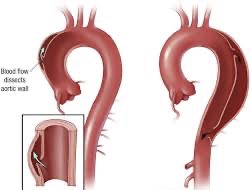 Thoracic ascending and descending, aortic dissections are associated with high morbidity and mortality.
Thoracic ascending and descending, aortic dissections are associated with high morbidity and mortality.
Patients often present in critical condition.
Beta blockers and pain relief are recommended in the initial management of patients with acute type A aortic dissection without severe aortic regurgitation.
For a patient with type A thoracic aortic dissection (ATAAD) emergency surgery is recommended.
For type B, aortic dissection, a stepwise approach is recommended to assess organ malperfusion or other indications of complicated disease.
If malperfusion, defined as end organ ischemia, is not present opting for medical therapy is the mainstay of treatment with uncomplicated type B thoracic aortic dissection.
For patients with ATAAD treated with emergency surgery show the mortality rate of 19.7% versus 57.1% for patients managed medically.
In patients with TBAD: malperfusion is defined as an organ ischemia, and may follow visceral, kidney, spinal, and/or extremity hypoperfusion.
Thoracic endovascular aortic repair is indicated for complicated hyperacute or subacute complications.
In TBAD when malperfusion is not present the mainstay of treatment is to lower systolic blood pressure, heart rate, and myocardial contractility using alpha blockers and beta blockers to minimize dissection propagation.
Following heart rate control, angiotensin, converting enzyme, inhibitors, angiotensin, receptor, blockers, and or calcium channel blockers may be useful.
